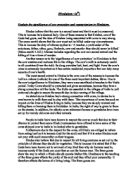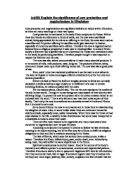Gandhi said that the cow was a symbol of Hinduism. As most Hindus are vegetarian, they believe in total respect to all living creatures. It has a very important role in India’s village life. The bulls (male cows) are used to pull along carts, plough fields and make grain into flower, which are all essential to life in a village. One bull and cow is enough to do all the work and supply enough food for more than one family. Hindus protect cows and other animals because of the teaching of Ahimsa. They believe all animals have the right to live their natural life span. As the cow is so scared to Hindus they have special ‘retirement homes’ called ‘Goshallas’ where they can rest and be cared for after they complete their working life. There are many cow protection agencies around the world, including ISKON. All members of ISKON are required to refrain from all meats, alcohols, onions, garlic and mushrooms. Many strict Hindus refrain from these as well. Most Hindus will just avoid meat, fish and eggs. Some Hindus eat fish, eggs and chicken but will still avoid beef.
During the BSE panic in 1996, many cows were slaughtered and in response, Hindus set up an “Adopt a Cow scheme.” This included donating a sum of money each month or year to care for a cow. In return people received prashad, holy food made from the cow’s milk. People are encouraged to make a pilgrimage to the Goshalla each year. At Bhaktivedanta Manor, in Hertfordshire there is a Goshalla, where elderly cows are taken in from farms to stop them from being slaughtered and they are able to live out their days peacefully and take part in festivals.
There are many reasons for a Hindu to be a vegetarian. Since the 6th centaury BCE when the idea of Ahimsa was introduced it has gradually become more popular amongst Hindus. As all living creatures have an atman, killing them would be killing the atman which is, in essence, harming Brahman. Thus most Hindus agree it’s wrong to kill an animal and to eat it. If a Hindu killed an animal they would gain bad karma, and so would ruin their chances of achieving moksha. As well as that they may, in their next life, be slaughtered and eaten. What people eat effects their consciousness, emotions and experimental pattern. Meat, eggs, fish and other animal foods increase anger levels. An important concept in Hinduism is that all living and non living objects have 3 basic qualities, the 3 Gunas. Sattvic is a positive and knowledgeable mind and is pure and clam. Rajastic is a neutral mind and is involved in worldly actions. Tamasic is a negative mind which is stagnant and ignorant. These qualities are said to be found in foods. Sattvic foods include milk, fruit and vegetables. Meats and eggs are linked with a Rajasic mind. Over ripe fruits and rotten foods will lead to a Tamasic mind.
Medical research shows that a vegetarian diet is easier to digest and provides better nutrients; Meat is unhealthy as it contains preservatives and poisons. Vegetarians are healthier than others and consequently live longer. Their immune systems are stronger and their bodies are unpolluted. It is much better to use natural resources and help preserve the environment. Hindus believe that should have a vegetable diet rather then killing animals.







